The strain type pressure sensors market is valued at USD 0.9 million in 2025 and is expected to reach USD 18.6 million by 2035, supported by expanding adoption of flexible electronic materials, rising integration of wearable monitoring technology, and growing interest in human–machine interaction interfaces. These sensors enable real-time deformation, motion, and pressure detection in formats that can be embedded into clothing, medical wearables, robotics surfaces, and protective equipment. Demand strengthens as industries shift toward lightweight, soft, and stretchable sensing platforms that can capture biomechanical signals without restricting movement. Healthcare, sports monitoring, rehabilitation, and virtual interaction systems increasingly rely on strain-sensitive sensing layers to generate actionable biometric and performance data.
From 2025 to 2030, the market increases from USD 0.9 million to approximately USD 3.1 million, adding USD 2.2 million in value and representing the early adoption stage. During this period, piezoresistive strain sensors gain traction due to their flexible substrate compatibility and low-profile form factor. Miniaturization, improved durability, and repeatable response performance become baseline expectations. From 2030 to 2035, market expansion accelerates significantly as applications scale into consumer wearables, smart textiles, and lightweight robotic skins, pushing the market to USD 18.6 million. Suppliers capable of delivering stable signal accuracy, skin-safe materials, and seamless integration with wireless data systems are positioned to capture long-term growth as strain-type pressure sensors evolve from research-driven prototypes to commercially standardized sensing components.

The latter half (2030-2035) will witness sustained growth from USD 3.1 million to USD 18.6 million, representing an addition of USD 15.5 million or 88% of the decade's expansion. This period will be defined by mass market penetration of specialized sensor designs, integration with comprehensive wearable platforms, and seamless compatibility with existing human-computer interaction infrastructure. The market trajectory signals fundamental shifts in how manufacturers approach flexible sensing optimization and signal quality management, with participants positioned to benefit from sustained demand across multiple sensing technology types and application segments.
The Strain Type Pressure Sensors market demonstrates distinct growth phases with varying market characteristics and competitive dynamics. Between 2025 and 2030, the market progresses through its technology adoption phase, expanding from USD 0.9 million to USD 3.1 million with steady annual increments averaging 34.7% growth. This period showcases the transition from basic strain sensing formulations to advanced piezoresistive systems with enhanced flexibility capabilities and integrated signal processing systems becoming mainstream features.
The 2025-2030 phase adds USD 2.2 million to market value, representing 12% of total decade expansion. Market maturation factors include standardization of wearable sensing and human-computer interaction protocols, declining component costs for specialized sensor formulations, and increasing industry awareness of flexible sensing benefits reaching optimal detection effectiveness in wearable and interactive applications. Competitive landscape evolution during this period features established sensor manufacturers like Aimedic MMT and Ningbo Elastech expanding their strain sensor portfolios while specialty manufacturers focus on advanced material development and enhanced sensitivity capabilities.
From 2030 to 2035, market dynamics shift toward advanced technology integration and global wearable expansion, with growth continuing from USD 3.1 million to USD 18.6 million, adding USD 15.5 million or 88% of total expansion. This phase transition centers on specialized sensing technology systems, integration with IoT networks, and deployment across diverse wearable and motion protection scenarios, becoming standard rather than specialized applications. The competitive environment matures with focus shifting from basic sensing capability to comprehensive data optimization systems and integration with AI-powered analytics platforms.
At-a-Glance Metrics
| Metric | Value |
|---|---|
| Market Value (2025) | USD 0.9 million |
| Market Forecast (2035) | USD 18.6 million |
| Growth Rate | 34.7% CAGR |
| Leading Technology | Piezoresistive Type Sensing Technology |
| Primary Application | Wearable Devices Application Segment |
The market demonstrates strong fundamentals with piezoresistive sensor systems capturing a dominant share through advanced strain detection and signal processing capabilities. Wearable device applications drive primary demand, supported by increasing consumer electronics adoption and flexible sensing technology requirements. Geographic expansion remains concentrated in developed markets with established consumer electronics infrastructure, while emerging economies show accelerating adoption rates driven by wearable technology expansion and rising health monitoring standards.
Market expansion rests on three fundamental shifts driving adoption across the wearable devices, human-computer interaction, and motion protection sectors. First, wearable technology demand creates compelling operational advantages through strain type pressure sensors that provide immediate pressure detection and motion tracking without compromising device comfort, enabling manufacturers to meet stringent performance standards while maintaining user experience and reducing device complexity. Second, human-computer interaction modernization accelerates as technology companies worldwide seek advanced sensing systems that complement traditional input methods, enabling precise gesture recognition and interaction control that align with industry standards and user experience requirements.
Third, health monitoring enhancement drives adoption from medical device manufacturers and wellness technology providers requiring effective sensing solutions that maximize data accuracy while maintaining operational reliability during continuous monitoring operations. However, growth faces headwinds from manufacturing complexity challenges that vary across sensor suppliers regarding the production of flexible substrates and nanomaterial integration, which may limit adoption in cost-sensitive environments. Technical limitations also persist regarding durability concerns and signal stability issues that may reduce effectiveness in high-strain or moisture exposure scenarios, which affect sensor performance and lifespan requirements.
The strain type pressure sensors market represents a specialized yet critical technology opportunity driven by expanding global wearable devices adoption, human-computer interaction modernization, and the need for superior pressure detection in diverse consumer applications. As manufacturers worldwide seek to achieve optimal sensing accuracy, reduce device footprint, and integrate advanced sensor systems with wireless platforms, strain type pressure sensors are evolving from basic pressure detectors to sophisticated sensing solutions ensuring user experience excellence and data reliability.
The market's growth trajectory from USD 0.9 million in 2025 to USD 18.6 million by 2035 at a 34.7% CAGR reflects fundamental shifts in wearable technology requirements and sensing optimization. Geographic expansion opportunities are particularly pronounced in Asia Pacific markets, while the dominance of piezoresistive sensing systems and wearable device applications provides clear strategic focus areas.
Strengthening the dominant piezoresistive sensor segment through enhanced material formulations, superior sensitivity response, and miniaturized production systems. This pathway focuses on optimizing nanomaterial composition, improving signal accuracy, extending operational effectiveness to optimal strain detection rates, and developing specialized formulations for diverse applications. Market leadership consolidation through advanced material engineering and flexible substrate integration enables premium positioning while defending competitive advantages against alternative sensing technologies. Expected revenue pool: USD 2.8-3.6 million
Rapid wearable device growth and consumer electronics development across Asia Pacific creates substantial expansion opportunities through local manufacturing capabilities and technology partnerships. Growing health monitoring adoption and government digital health initiatives drive sustained demand for advanced sensor systems. Market penetration strategies reduce production costs, enable faster technical support, and position companies advantageously for consumer electronics programs while accessing growing domestic markets. Expected revenue pool: USD 2.4-3.1 million
Expansion within the dominant wearable devices segment through specialized sensor designs addressing fitness tracker standards and smartwatch integration requirements. This pathway encompasses wireless connectivity compatibility, battery efficiency optimization, and alignment with diverse consumer electronics manufacturing processes. Premium positioning reflects superior sensing accuracy and comprehensive device integration supporting modern wearable production. Expected revenue pool: USD 2.0-2.7 million
Strategic expansion into human-computer interaction applications requires enhanced gesture recognition capabilities and specialized sensor formulations addressing interactive system operational requirements. This pathway addresses multi-touch detection, pressure mapping precision, and haptic feedback integration with advanced material engineering for demanding interface standards. Premium pricing reflects specialized performance requirements and extended reliability standards. Expected revenue pool: USD 1.7-2.3 million
Development of specialized sensor formulations for motion protection applications addressing athletic equipment requirements and safety monitoring demands. This pathway encompasses impact detection designs, real-time monitoring capabilities, and cost-effective solutions for sports technology segments. Technology differentiation through rapid-response formulations enables diversified revenue streams while reducing dependency on single application platforms. Expected revenue pool: USD 1.4-1.9 million
Expansion of capacitive sensor segment through enhanced touch sensitivity, multi-layer detection capabilities, and specialized pressure mapping requirements. This pathway encompasses touchscreen applications, flexible display integration, and formulations requiring superior spatial resolution characteristics. Market development through advanced capacitive engineering enables differentiated positioning while accessing specialized markets requiring multi-touch sensing solutions. Expected revenue pool: USD 1.2-1.6 million
Development of medical-grade sensor formulations addressing regulatory compliance and continuous monitoring requirements across wearable health and motion protection applications. This pathway encompasses biocompatibility certifications, long-term stability validation, and comprehensive clinical documentation. Premium positioning reflects medical device expertise and regulatory compliance excellence while enabling access to healthcare-focused procurement programs and clinical monitoring partnerships. Expected revenue pool: USD 1.0-1.4 million
Primary Classification: The market segments by sensing technology into Piezoresistive Type, Capacitive Type, Piezoelectric Type, and Others categories, representing the evolution from basic strain detection to specialized sensing solutions for comprehensive pressure monitoring.
Secondary Classification: Application segmentation divides the market into Wearable Devices, Human-computer Interaction, Motion Protection, and Others sectors, reflecting distinct requirements for sensing accuracy, response time, and integration standards.
Regional Classification: Geographic distribution covers Asia Pacific, Europe, North America, Latin America, and Middle East & Africa, with developed markets leading adoption while emerging economies show accelerating growth patterns driven by consumer electronics expansion programs.
The segmentation structure reveals technology progression from standard piezoresistive formulations toward specialized sensing systems with enhanced flexibility and signal processing capabilities, while application diversity spans from wearable health monitoring to specialized gesture control and sports technology applications requiring precise strain sensors.

Market Position: Piezoresistive sensor systems command the leading position in the Strain Type Pressure Sensors market with approximately 52.0% market share through advanced material properties, including superior strain sensitivity, optimal signal linearity capability, and detection optimization that enable manufacturers to achieve optimal pressure measurement across diverse wearable environments.
Value Drivers: The segment benefits from engineer preference for reliable sensing systems that provide consistent pressure response, reduced signal noise, and manufacturing scalability without requiring significant process modifications. Advanced material features enable flexible integration, miniaturization compatibility, and alignment with existing consumer electronics equipment, where sensor performance and signal reliability represent critical operational requirements.
Competitive Advantages: Piezoresistive sensor systems differentiate through proven resistance change characteristics, consistent calibration properties, and integration with wireless transmission systems that enhance sensing effectiveness while maintaining optimal accuracy suitable for diverse wearable sensing applications.
Key market characteristics:
Capacitive sensor systems maintain specialized technology positioning in the Strain Type Pressure Sensors market due to their touch sensitivity properties and multi-point detection advantages. These systems appeal to manufacturers requiring spatial resolution with adequate performance for touchscreen and interactive surface applications. Market adoption is driven by human-computer interaction expansion, emphasizing precise touch detection solutions and operational efficiency through optimized capacitive design systems while maintaining competitive performance characteristics.
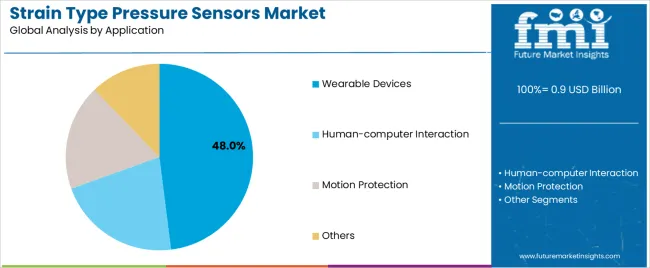
Market Context: Wearable device applications dominate the Strain Type Pressure Sensors market with approximately 48.0% market share due to widespread adoption of fitness tracking and increasing focus on health monitoring, activity recognition, and wellness management applications that minimize device complexity while maintaining sensing standards.
Appeal Factors: Wearable device manufacturers prioritize sensing accuracy, power efficiency, and integration with existing microcontroller infrastructure that enables coordinated sensor application across multiple device functions. The segment benefits from substantial consumer electronics investment and health technology programs that emphasize the acquisition of strain sensors for data collection and user interaction applications.
Growth Drivers: Fitness tracker expansion programs incorporate strain type pressure sensors as standard components for wellness monitoring operations, while smartwatch industry growth increases demand for multi-functional sensing capabilities that comply with consumer electronics standards and minimize device footprint.
Market Challenges: Varying device standards and wearable form factor differences may limit sensor standardization across different product categories or operational scenarios.
Application dynamics include:
Human-computer interaction applications capture approximately 32.0% market share through specialized sensing requirements in touchscreen systems, gesture control devices, and interactive surface applications. These systems demand precise sensor capabilities for detecting pressure variations while providing spatial resolution and multi-touch recognition capabilities.
Motion protection applications account for approximately 14.0% market share, while other segments capture 6.0%, including gaming controllers, automotive interfaces, and specialty consumer electronics requiring sensor capabilities for diverse interaction scenarios and pressure monitoring.
Growth Accelerators: Wearable technology expansion drives primary adoption as strain type pressure sensors provide superior detection capabilities that enable consumer electronics manufacturers to meet stringent performance standards without excessive device costs, supporting health monitoring operations and wellness missions that require precise pressure sensing applications. Flexible electronics infrastructure demand accelerates market expansion as technology companies seek effective sensing solutions that minimize device thickness while maintaining operational effectiveness during continuous monitoring and interaction scenarios. Consumer electronics innovation spending increases worldwide, creating sustained demand for sensing systems that complement traditional input methods and provide user experience improvement in competitive technology markets.
Growth Inhibitors: Manufacturing complexity challenges vary across sensor suppliers regarding the production of flexible substrates and nanomaterial deposition, which may limit operational flexibility and market penetration in regions with limited advanced manufacturing capabilities or cost-constrained production environments. Technical performance limitations persist regarding long-term durability and environmental sensitivity that may reduce effectiveness in moisture exposure, temperature variations, or mechanical stress conditions, affecting sensor reliability and replacement frequency. Market fragmentation across multiple device standards and integration protocols creates compatibility concerns between different sensor suppliers and existing consumer electronics infrastructure.
Market Evolution Patterns: Adoption accelerates in fitness trackers and smartwatch sectors where sensing accuracy justifies sensor costs, with geographic concentration in developed markets transitioning toward mainstream adoption in emerging economies driven by consumer electronics expansion and health awareness. Technology development focuses on enhanced nanomaterial formulations, improved environmental resistance, and integration with AI analytics systems that optimize data interpretation and sensing effectiveness. The market could face disruption if alternative pressure sensing technologies or optical detection innovations significantly limit the deployment of strain-based sensors in wearable applications, though flexible sensor technology's unique combination of thin form factor, low power consumption, and high sensitivity continues to make it preferred in wearable device integration.
The Strain Type Pressure Sensors market demonstrates varied regional dynamics with Growth Leaders including China (46.8% CAGR) and India (43.4% CAGR) driving expansion through consumer electronics capacity additions and wearable technology programs. Steady Performers encompass Germany (39.9% CAGR), Brazil (36.4% CAGR), and United States (33.0% CAGR), benefiting from established technology sectors and advanced innovation adoption. Mature Markets feature United Kingdom (29.5% CAGR) and Japan (26.0% CAGR), where specialized wearable applications and precision sensing integration support consistent growth patterns.
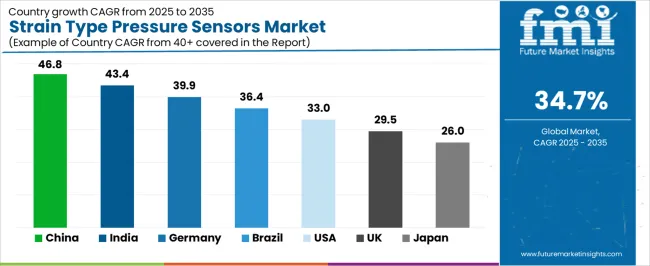
| Country | CAGR (2025-2035) |
|---|---|
| China | 46.8% |
| India | 43.4% |
| Germany | 39.9% |
| Brazil | 36.4% |
| United States | 33.0% |
| United Kingdom | 29.5% |
| Japan | 26.0% |
Regional synthesis reveals Asia Pacific markets leading adoption through consumer electronics infrastructure expansion and wearable device manufacturing development, while European countries maintain strong expansion supported by technology innovation advancement and quality standardization requirements. North American markets show substantial growth driven by health technology applications and wearable device integration trends.
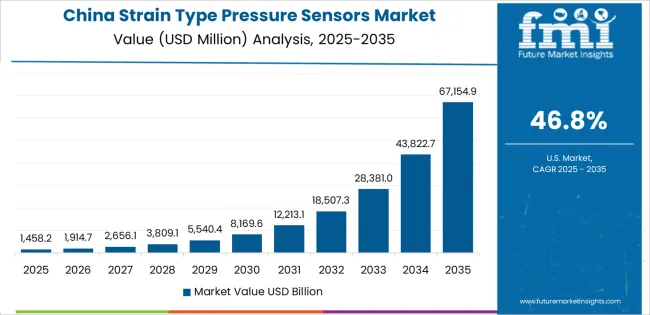
The Chinese market emphasizes advanced sensing features, including precision pressure detection and integration with comprehensive IoT platforms that manage data collection, analytics optimization, and wireless applications through unified monitoring systems. The country demonstrates exceptional growth at 46.8% CAGR, driven by consumer electronics infrastructure expansion, wearable device manufacturing, and emerging health technology initiatives that support sensor integration. Chinese manufacturers prioritize production effectiveness with strain type pressure sensors delivering consistent sensing performance through advanced material capabilities and manufacturing adaptation features.
Technology deployment channels include major consumer electronics manufacturers, specialized sensor suppliers, and technology procurement programs that support product applications for complex wearable device integration and human-computer interaction applications. IoT platform integration capabilities with established wireless systems expand market appeal across diverse operational requirements seeking sensing benefits and data collection improvement. The expanding consumer electronics base and accelerating wearable technology adoption create sustained demand, while innovative applications in health monitoring and smart home devices open new growth avenues.
Performance Metrics:
Germany's advanced technology market demonstrates sophisticated sensor deployment with documented operational effectiveness in wearable device applications and consumer electronics facilities through integration with existing innovation systems and production infrastructure. The country leverages engineering expertise in precision sensing and manufacturing systems integration to maintain exceptional growth at 39.9% CAGR. Technology centers, including Munich, Berlin, and Stuttgart, showcase advanced installations where sensor systems integrate with comprehensive development platforms and quality management systems to optimize product performance and sensing effectiveness.
German technology companies prioritize system innovation and EU compliance in sensor development, creating demand for precision-engineered systems with advanced features, including wireless integration and automated calibration systems. The market benefits from established innovation infrastructure and willingness to invest in advanced technologies that provide long-term competitive benefits and compliance with international quality and safety standards.
Market Intelligence Brief:
The USA strain type pressure sensors market demonstrates sophisticated deployment across wearable applications with documented effectiveness in health monitoring and consumer electronics facilities through integration with comprehensive digital health systems and innovation infrastructure. The country leverages advanced technology capabilities in sensor innovation and data analytics technologies to maintain substantial growth at 33.0% CAGR. Technology centers, including Silicon Valley, Boston, and Seattle, showcase advanced installations where sensor systems integrate with comprehensive health platforms and mobile ecosystems to optimize user experience and sensing effectiveness.
American technology companies prioritize data accuracy and device integration in sensor development, creating demand for innovative sensing systems with advanced features, including AI analytics integration and cloud connectivity systems. The market benefits from established digital health infrastructure and willingness to invest in wellness technologies that provide long-term health benefits and compliance with FDA and consumer electronics standards.
Market Intelligence Brief:
The UK strain type pressure sensors market demonstrates advanced technology deployment with documented operational effectiveness in wearable applications and consumer electronics facilities through integration with existing innovation systems and development infrastructure. The country leverages technology expertise in health monitoring and device systems integration to maintain substantial growth at 29.5% CAGR. Technology centers, including London, Cambridge, and Manchester, showcase advanced installations where sensor systems integrate with comprehensive health platforms and wellness management systems to optimize device performance and sensing effectiveness.
British technology companies prioritize system reliability and regulatory compliance in sensor development, creating demand for validated systems with advanced features, including health data integration and performance monitoring. The market benefits from established innovation infrastructure and commitment to invest in health technologies that provide long-term wellness benefits and compliance with UK and EU technology standards. Wearable health applications, fitness tracking systems, and wellness monitoring drive diversified demand across multiple consumer segments.
Strategic Market Indicators:
India's strain type pressure sensors market demonstrates rapid expansion deployment with documented operational effectiveness in consumer electronics applications and wearable device facilities through integration with emerging technology systems and manufacturing infrastructure. The country leverages growing technology capabilities in sensor production and device systems integration to achieve exceptional growth at 43.4% CAGR. Technology centers, including Bangalore, Mumbai, and Hyderabad, showcase expanding installations where sensor systems integrate with comprehensive device platforms and consumer networks to optimize market penetration and sensing effectiveness.
Indian technology companies prioritize innovation capability and international standards in sensor development, creating demand for advanced systems with enhanced features, including wireless integration and data processing systems. The market benefits from expanding consumer electronics infrastructure and willingness to invest in international-standard sensing technologies that provide competitive differentiation and compliance with global quality standards.
Market Intelligence Brief:
Brazil's strain type pressure sensors market demonstrates expanding technology deployment with documented effectiveness in consumer electronics applications and wearable device facilities through integration with developing innovation systems and manufacturing infrastructure. The country leverages growing technology capabilities in sensor production and device integration to achieve substantial growth at 36.4% CAGR. Technology centers, including São Paulo, Rio de Janeiro, and Campinas, showcase expanding installations where sensor systems integrate with consumer platforms and device networks to optimize product performance and market penetration.
Brazilian technology companies prioritize sensing reliability and quality compliance in sensor development, creating demand for proven systems with advanced features, including standardized integration and performance monitoring. The market benefits from expanding consumer electronics infrastructure and commitment to invest in sensing technologies that provide competitive benefits and compliance with regional technology standards.
Strategic Market Indicators:
Japan's strain type pressure sensors market demonstrates precision deployment with documented operational effectiveness in wearable applications and consumer electronics facilities through integration with advanced technology systems and quality infrastructure. The country leverages manufacturing excellence in precision sensing and systems integration to maintain substantial growth at 26.0% CAGR. Technology centers, including Tokyo, Osaka, and Nagoya, showcase advanced installations where sensor systems integrate with comprehensive quality platforms and device systems to optimize sensing excellence and performance effectiveness.
Japanese technology companies prioritize system precision and performance validation in sensor development, creating demand for ultra-precision systems with advanced features, including micro-level detection capabilities and quality integration systems. The market benefits from established consumer electronics infrastructure and commitment to invest in highest-quality sensing technologies that provide superior detection accuracy and compliance with stringent Japanese technology standards.
Strategic Market Indicators:

The Strain Type Pressure Sensors market in Europe is projected to grow substantially over the forecast period, with Germany expected to maintain its leadership position with a significant market share supported by its advanced technology infrastructure and major innovation centers in Munich and Berlin. France follows with strong market presence, driven by comprehensive consumer electronics programs and wearable technology initiatives. The United Kingdom holds substantial market share through specialized health technology activities, innovation programs, and wearable device development. Italy commands notable market presence through strong consumer electronics projects and technology expansion. Spain accounts for growing market share aided by wearable device manufacturing growth and technology adoption. The Netherlands maintains steady share driven by specialty sensing applications and innovation demand. The Rest of Europe region is anticipated to show steady adoption, reflecting consistent growth in Nordic countries, technology expansion in Central European markets, and innovation upgrades across Eastern European consumer electronics facilities.
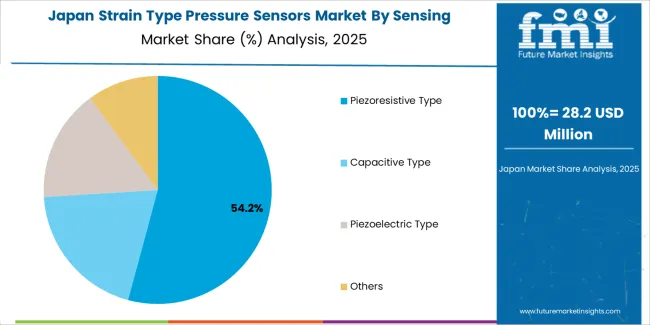
In Japan, the Strain Type Pressure Sensors market prioritizes piezoresistive sensor systems, which capture the dominant share of wearable device and consumer electronics installations due to their advanced features, including precision strain detection optimization and seamless integration with existing device infrastructure. Japanese technology companies emphasize reliability, precision, and long-term performance excellence, creating demand for piezoresistive systems that provide consistent sensing capabilities and superior material performance based on device requirements and quality standards. Capacitive type maintains secondary positions primarily in touchscreen applications and interactive surface installations where comprehensive spatial resolution meets operational requirements without compromising device efficiency.
Market Characteristics:
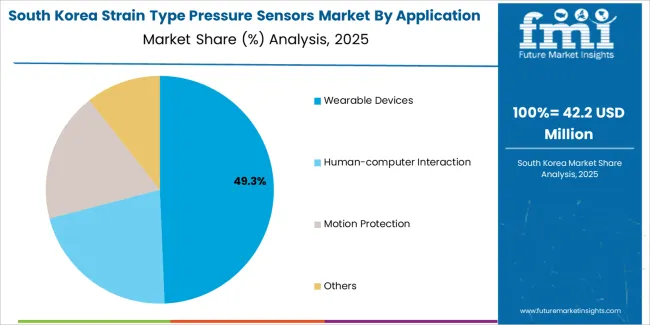
In South Korea, the market structure favors international sensor manufacturers, including Aimedic MMT, Ningbo Elastech, and Soft Sense, which maintain dominant positions through comprehensive product portfolios and established technology networks supporting both wearable device and consumer electronics installations. These providers offer integrated solutions combining advanced sensor systems with technical engineering services and ongoing application support that appeal to Korean technology companies seeking reliable sensing systems. Local distributors and specialty suppliers capture moderate market share by providing localized service capabilities and competitive pricing for standard sensing installations, while domestic manufacturers focus on specialized applications and cost-effective solutions tailored to Korean consumer electronics market characteristics.
Channel Insights:
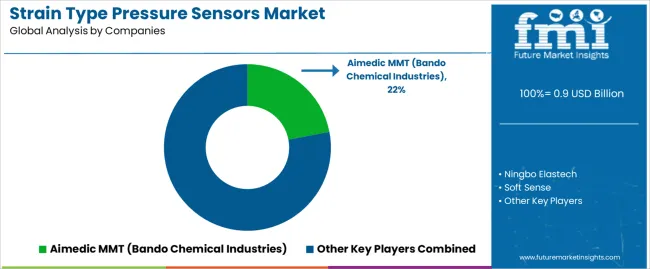
The Strain Type Pressure Sensors market operates with moderate concentration, featuring approximately 12-16 meaningful participants, where leading companies control roughly 45-50% of the global market share through established technology relationships and comprehensive flexible sensing portfolios. Competition emphasizes advanced material capabilities, sensing accuracy, and device integration rather than price-based rivalry. The leading company, Aimedic MMT (Bando Chemical Industries), commands approximately 22.0% market share through its extensive flexible sensor product line and global consumer electronics presence.
Market Leaders encompass Aimedic MMT (Bando Chemical Industries), Ningbo Elastech, and Soft Sense, which maintain competitive advantages through extensive nanomaterial expertise, global technology networks, and comprehensive device integration capabilities that create customer loyalty and support premium pricing. These companies leverage decades of flexible electronics experience and ongoing research investments to develop advanced sensor systems with precision strain detection and durability features. Technology Innovators include Suzhou Leanstar Electronic Technology and regional specialists, which compete through specialized material technology focus and innovative design capabilities that appeal to device manufacturers seeking advanced sensing solutions and performance differentiation.
These companies differentiate through rapid development cycles and specialized wearable application focus. Regional Specialists feature sensor manufacturers focusing on specific geographic markets and specialized applications, including medical-grade systems and integrated health monitoring solutions. Market dynamics favor participants that combine reliable sensing formulations with advanced detection capabilities, including precision strain measurement and automatic signal optimization features. Competitive pressure intensifies as traditional flexible electronics suppliers expand into specialized strain sensing systems, while consumer electronics companies challenge established players through innovative material solutions and integrated platforms targeting wearable device and human-computer interaction segments.
| Item | Value |
|---|---|
| Quantitative Units | USD 0.9 Million |
| Sensing Technology | Piezoresistive Type, Capacitive Type, Piezoelectric Type, Others |
| Application | Wearable Devices, Human-computer Interaction, Motion Protection, Others |
| Regions Covered | Asia Pacific, Europe, North America, Latin America, Middle East & Africa |
| Countries Covered | China, India, Germany, Brazil, United States, United Kingdom, Japan, and 20+ additional countries |
| Key Companies Profiled | Aimedic MMT (Bando Chemical Industries), Ningbo Elastech, Soft Sense, Suzhou Leanstar Electronic Technology |
| Additional Attributes | Dollar sales by sensing technology and application categories, regional adoption trends across Asia Pacific, Europe, and North America, competitive landscape with flexible sensor manufacturers and consumer electronics suppliers, manufacturer preferences for sensing accuracy and device integration, integration with wearable platforms and health monitoring systems, innovations in nanomaterial formulations and detection excellence, and development of wireless connectivity solutions with enhanced performance and miniaturization capabilities. |
The global strain type pressure sensors market is estimated to be valued at USD 0.9 billion in 2025.
The market size for the strain type pressure sensors market is projected to reach USD 17.7 billion by 2035.
The strain type pressure sensors market is expected to grow at a 34.7% CAGR between 2025 and 2035.
The key product types in strain type pressure sensors market are piezoresistive type, capacitive type, piezoelectric type and others.
In terms of application, wearable devices segment to command 48.0% share in the strain type pressure sensors market in 2025.






Full Research Suite comprises of:
Market outlook & trends analysis
Interviews & case studies
Strategic recommendations
Vendor profiles & capabilities analysis
5-year forecasts
8 regions and 60+ country-level data splits
Market segment data splits
12 months of continuous data updates
DELIVERED AS:
PDF EXCEL ONLINE
Strain Clamp Market Size and Share Forecast Outlook 2025 to 2035
Multistrain Probiotics Market Analysis - Size, Share, and Forecast Outlook 2025 to 2035
Single-strain Probiotics Market
Comprehensive Probiotic Strains market analysis and forecast by strain type, application and region.
Industrial Strainers Market Size and Share Forecast Outlook 2025 to 2035
UK Probiotic Strains Market Trends – Growth, Demand & Forecast 2025–2035
USA Probiotic Strains Market Report – Trends, Demand & Industry Forecast 2025–2035
Automotive Oil Strainer Market
Demand for Multistrain Probiotics in EU Size and Share Forecast Outlook 2025 to 2035
ASEAN Probiotic Strains Market Analysis – Size, Share & Forecast 2025–2035
Europe Probiotic Strains Market Outlook – Share, Growth & Forecast 2025–2035
Australia Probiotic Strains Market Growth – Trends, Demand & Innovations 2025–2035
Demand of No-acid Whey Strained Dairy Processing Concepts in European Union Size and Share Forecast Outlook 2025 to 2035
Latin America Probiotic Strains Market Insights – Demand, Size & Industry Trends 2025–2035
Type 1 Commercial Surge Protection Devices Market Size and Share Forecast Outlook 2025 to 2035
Type-C Bulk Bags Market Size and Share Forecast Outlook 2025 to 2035
Competitive Overview of Type-C Bulk Bags Companies
V-type Classifiers Market Size and Share Forecast Outlook 2025 to 2035
V Type Fin Condenser Market Size and Share Forecast Outlook 2025 to 2035
V Type Air Cooled Condenser Market Size and Share Forecast Outlook 2025 to 2035

Thank you!
You will receive an email from our Business Development Manager. Please be sure to check your SPAM/JUNK folder too.
Chat With
MaRIA